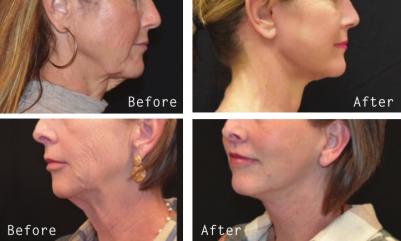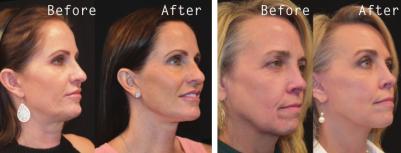Knocking Off Ten Years

Working magic with facial lift surgeries
Facelifts are not what they used to be!
The days of Kenny Rogers and Joan Rivers with their unnatural pulled look, wide lips and wind-blown sweeping cheeks are long gone. Facelift techniques have become more sophisticated over the years and now are boasting natural-looking results that last. Dr. Lindsey Pennington is a Shreveportbased facial plastic and reconstructive surgeon who specializes in facial rejuvenation.
“More and more patients are coming to me asking for rejuvenation procedures but want the results to be natural with minimal downtime.”
There have been a lot of stigmas associated with undergoing a facelift. Patients were left with obvious scars, wind-blownappearing skin pulled and then, in addition, months of downtime. Now with advanced techniques such as the deep plane facelift, extended SMAS facelift and vertical lift, superior, natural-looking results and higher patient satisfaction are realized.
Dr. Pennington, tell us, what exactly is a facelift?
A facelift, also known as a rhytidectomy, is a surgical procedure designed to restore a more youthful appearance by improving volume loss, wrinkles and sagging skin around the face and neck. During the surgery, the underlying fascia and muscles of the face and neck are tightened, and excess skin is removed. A facelift improves both wrinkles and sagging skin in the face, along the jawline, and in the neck area. This surgery can be combined with other procedures such as liposuction, eyelid surgery or lip lift to help with the general features of aging.
Who is a good candidate for a facelift?
The patient population that comes through my office doors looking to get a facelift is typically my more active patients. It’s people who are still working, volunteering and have an active lifestyle and just want to look the way they feel! They are trying to stay relevant in the workforce and want to look good for their age. There is no set age or profile for those considering a facelift. Facelifts are individualized considering the patient’s skin elasticity, body type and size. Age tends to be less of a factor than the characteristics of the patient’s skin and overall goals, but patients range from their 40s and upwards of 70s.
What is the most common question you get asked about facelifts from patients?
How long is the downtime and will I look different?
Because my patients are so active and busy with life, the downtime is usually the hardest part for them to coordinate. I tell my facelift patients to expect a full two weeks of downtime after the surgery. This means hanging out at home, reading and watching Netflix for a full two weeks! Of course, the full recovery time is patient-dependent, but in general, after two weeks most of the swelling and bruising has subsided, and patients can wear makeup again and return to work. To be sure you will be at your best for a special occasion or event, I always recommend giving yourself at least a month before the event. Most of my patients do not experience much pain during this process, it is more of a discomfort factor and looking swollen and bruised.
Many post-operative patients don’t even take any of the pain medications that I prescribe them.
Will I look different?
The goal with a facelift is to keep you looking like you, but a more youthful, natural version of yourself. A reasonable goal for facelift surgery is to have the patient appear about 10 years younger. Most of my patients report looking and feeling very “refreshed” after their surgery. A facelift done by a skilled surgeon will make the patient look younger rather than different, or “operated on.” I work very hard on all my facelifts to be sure they are getting the absolute best, most natural and long-lasting results possible.
As a facial plastic surgeon with specialized experience in operating on the face, I perform many different types of facelifts depending on that patient’s anatomy and goals. The facelift technique I most commonly use when performing my surgeries is the deep plane facelift. When a facelift looks unnatural, it is usually because the patient’s skin looks like it has been pulled, giving a very “wind-blown” look. The reason this looks odd is that the underlying facial structures change with aging. Not only does our outer skin become thinner and start to sag, but the fat, muscle and even bone in the face lose shape and volume.
For this reason, a natural-looking result is achieved by focusing on those underlying structures and not just the skin that sits on top. Getting the correct balance between facial structure and skin correction is a finely-tuned skill that requires a wealth of experience that I focus on every time. With the deep plane facelift, I address those underlying structures, returning them to their original location. This way, I can drape the skin over the top of those tightened underlying structures, accomplishing a very natural look to my results that are long-lasting.
Not pulling the skin so tight that you lose the natural contours of the face is also very important.
What happens during a consultation for my facelift?
We first discuss the patient’s goals for the consultation and areas that they are concerned with. I perform a detailed physical exam, and we will take photos on our 2D and 3D cameras. Then we will go back to my office and look at the pictures together. The 3D pictures are done with Vectra software, which allows me to modify different aspects of the patients face to simulate potential surgical outcomes. People are also able to view before and after photos of other
facelifts I have performed. I then go over in detail the process of the surgical steps involved with the recommended procedure, where the incisions are located, the aftercare, and what the patients can expect in the weeks following the procedure.
What to look for when choosing a surgeon?
The number one thing is a relationship with trust. Do you have similar styles and goals? Or does that surgeon insist on making everyone look like his or her idea of beauty that they pulled from a Hollywood celebrity? Facial plastic surgery has the capability of looking extremely natural.
Your surgeon needs to be able to take the time and sit down with you and actually listen to your goals and vision of ideal beauty. They should be able to be honest if your goals are unrealistic, and whether they can be obtained with a minimally-invasive inoffice procedure or something much more involved such as surgery. It’s all about open communication.
I recommend seeking out a surgeon who specializes in the procedures you are interested in. Facial plastic surgery is an artistic subspecialty, which requires both an artistic eye and technical skills. Facial plastic and reconstructive surgeons are certified by the American Board of Otolaryngology Head and Neck Surgery as well as the American Board of Facial Plastic and Reconstructive Surgery. This dual training gives facial plastic surgeons expert knowledge of facial form and function.
Dr. Lindsey Pennington is a facial plastic and reconstructive surgeon. She offers complimentary consults to discuss any procedures or questions patients may have. Her office is located at 6030 Line Ave., Suite 110 in Shreveport. Phone (318)216-5366. Before and after photos can be viewed in office for patient privacy, and some are available online on Instagram and Facebook @ penningtonfacialplastics.
